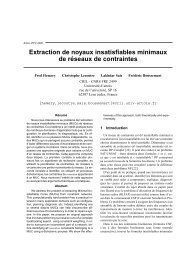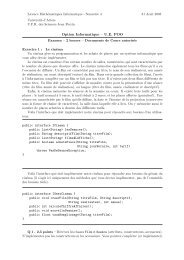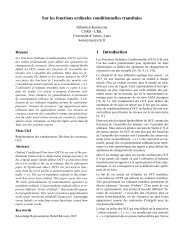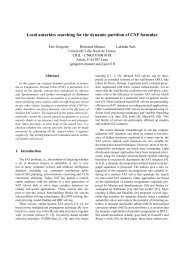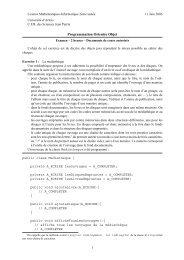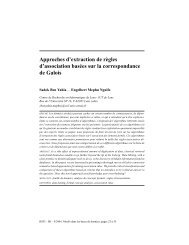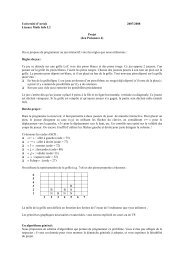Introduction à la Théorie des Jeux - CRIL
Introduction à la Théorie des Jeux - CRIL
Introduction à la Théorie des Jeux - CRIL
You also want an ePaper? Increase the reach of your titles
YUMPU automatically turns print PDFs into web optimized ePapers that Google loves.
La guerre <strong>des</strong> sexes<br />
Joueur 2<br />
y 1 − y<br />
Joueur 1<br />
f<br />
f<br />
2,1<br />
c<br />
0,0 x<br />
c 0,0 1,2 1 − x<br />
Soit x <strong>la</strong> probabilité avec <strong>la</strong>quelle le joueur 1 joue f, quelle est <strong>la</strong> meilleure<br />
réponse du joueur 2 ?<br />
µ2(< (f, x), (c, 1 − x) >, f) = x ∗ 1 + (1 − x) ∗ 0 = x<br />
µ2(< (f, x), (c, 1 − x) >, c) = x ∗ 0 + (1 − x) ∗ 2 = 2(1 − x)<br />
Donc:<br />
⊲ Si x > 2(1 − x) (x > 2/3), <strong>la</strong> meilleure réponse du joueur 2 est de jouer f<br />
⊲ Si x < 2(1 − x) (x < 2/3), <strong>la</strong> meilleure réponse du joueur 2 est de jouer c<br />
⊲ Si x = 2(1 − x) (x = 2/3), le joueur 2 est indifférent entre f et c, il peut<br />
donc jouer l’une ou l’autre, ou n’importe quelle combinaison <strong>des</strong> deux.<br />
<strong>Introduction</strong> <strong>à</strong> <strong>la</strong> <strong>Théorie</strong> <strong>des</strong> <strong>Jeux</strong> – p.36/77



